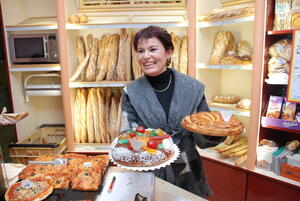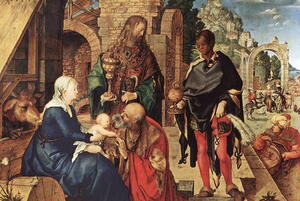A toroidal brioche to celebrate the Wise Men from the East
In the week following 6 January, every family in Provence engages in a heated debate: Will the "Three Kings cake" be a "gâteau" or a "galette"? Traditionalists are in favour of "le gâteau," a fat toroidal brioche covered with thick slices of candied fruits; modernists prefer the round, almond paste filled Parisian tart or "galette." But whatever their choice, the ritual of the Epiphany meal, also called "Fête des Rois," or Kings' Festival, will remain the same.
A dry broad bean, called a "fève," and a small porcelain (or plastic) figurine have been baked into the cake. The youngest child among the guests hides under the table and decides who will get the portion of the cake being sliced by the family head. Whoever finds the figurine is crowned king or queen, while the unfortunate who "gets the bean" is supposed to treat everyone present to another cake and champagne.
What is being celebrated in this rather heathen fashion is one of the most poetic and stirring event surrounding the Nativity: The arrival in Bethlehem, twelve days after the Infant Jesus was born, of the "Magi," or "Wise Men," bringing gifts of gold, frankincense and myrrh. From their home "in the East," they had been guided by a miraculous star. The Wise Men, who may have been priests-astrologists from Babylon or Persia, are symbols of the nations of the Earth bearing witness to the new age of the world—this is the meaning of "Epiphany," which means "Revelation."
Matthew is the only one of the four Evangelists to recount this event, and only in later centuries did the "Adoration of the Magi" acquire a deep symbolic and emotional significance. Popular faith in the early Middle Ages transformed the anonymous Wise Men into three kings named Caspar, Melchior and Balthazar.
How the Epiphany led to broad beans baked into torus-shaped brioches is another case of a pagan tradition being incorporated into a Christian holiday. In Roman times, during the Saturnalia celebrations at the beginning of winter, slaves would be crowned king of a day when they found the bean in the cake.



